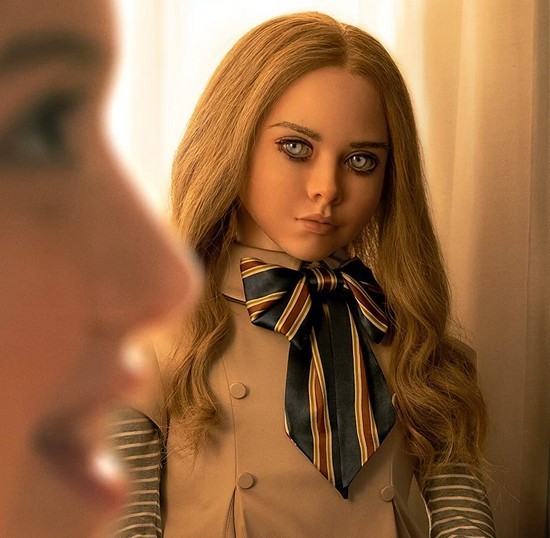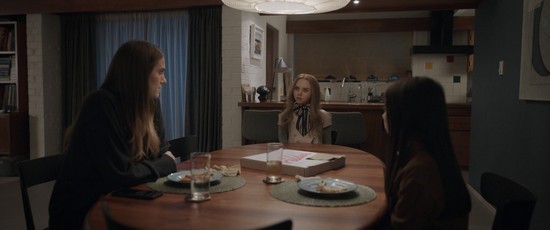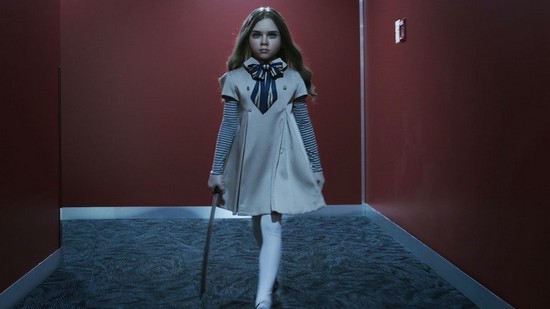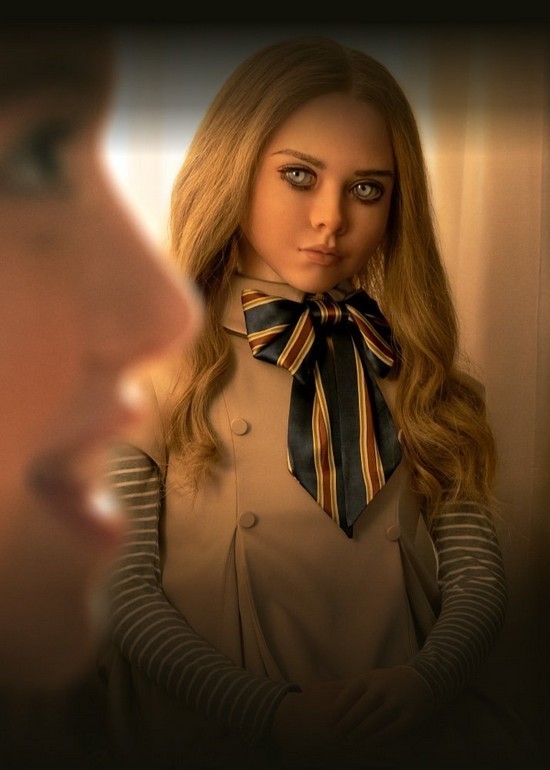Who here is afraid of dancing robots?
New York Times
last updated: Jan 08,2023

M3GAN is not a born mover. The robot doll at the center of the film “M3GAN”
starts out stiff-limbed and jerky, prone to sharp, birdlike tilts of the head —
C3PO, if he were styled by toymaker Madame Alexander.اضافة اعلان
But once M3GAN, short for Model 3 Generative Android, discovers more about what it means to be a person, her movements begin to smooth out. In a montage, we see the robot learn a simple TikTok-style dance alongside the young girl she is programmed to befriend and protect. As M3GAN’s understanding of that programming evolves into something more malevolent, she advances to sinuous, sinister bodily virtuosity. When the film reaches its bloody denouement, she executes a routine to rival anything seen on a television dance competition: rolling through her spine, swiveling her hips, flinging herself into a hands-free cartwheel.

The internet found the uncanny absurdity of that dance scene — much of which ended up in the first trailer for “M3GAN,” which opened last week — irresistible. Thousands of fans recreated or otherwise meme-ified M3GAN’s choreography on social media.
“That dance is so specifically eerie,” said Gerard Johnstone, the director of “M3GAN.” “It’s been crazy to see it end up in the internet history books.”
People have been afraid of robots for as long as robots have existed. But robots that can dance — really dance — are distinctly unnerving. A gleefully campy horror-comedy, “M3GAN” plays on the mixture of amusement and deep unease that real-life dancing robots often provoke.
Over the past several years, robotics company Boston Dynamics has released a series of dance videos showcasing its sophisticated machines, their metal-clad bodies step-touching, twerking, and bourrée-ing to the beats of popular songs. “Do You Love Me,” an intricately choreographed video featuring the humanoid Atlas robot, the doglike Spot and the wheeled model then called Handle, generated a viral flurry when it came out at the end of 2020. Commenters both marveled and shuddered at the machines’ slick proficiency. Actor-comedian Seth Rogen mused about how “it would actually be funny” if the robots danced “as they kill us all” on Twitter.

“When you see the Boston Dynamics robots dancing in perfect unison,” Johnstone said, “it’s almost like them looking at us and saying, ‘We can do what you do, and we can do it better,’ in the most obnoxious way”. He chuckled. “Like they are going to sashay their way toward the extermination of all humanity.”
M3GAN’s ice-cold, ruthlessly calculated “performance” stands in contrast to the human dancing in some recent horror films, where flesh-and-bone bodies reach states of overheated delirium. Choreographer, director, and writer Jack Ferver, who worked on the coming horror movie “The Parenting”, said dance horror is effective when the person dancing “transcends their personhood”.
But what does that mean for a nonperson? Robots are not dead behind the eyes because they are in some kind of ecstatic trance; they are dead behind the eyes because they are not alive.
In the realm of the imaginary, a rich legacy leads to “M3GAN”. Mechanical dolls dot dance history — particularly in ballet, whose canon dates mostly to the 19th century, a period when the rise of mechanized industry spurred anxieties about the consequences of automation. (The comic ballet “Coppélia” features an inventor who dreams of bringing the mechanical doll of the title to life; a recent film version of the ballet recasts Coppélia as a robot). Dangerous androids have played influential roles throughout film and pop culture history, especially recently, as the rapid advancements of the computer age have made robot-apocalypse scenarios feel more and more plausible. In literature, fantasies about the consequences of animating inanimate objects go back through “Frankenstein” all the way to Pygmalion and Prometheus.

“You can see that there’s a genealogy here that results in a TikTok-dancing murder robot named M3GAN,” said Sydney Skybetter, a professor of choreography and emerging technologies at Brown University. “This is fundamentally some old, old stuff.”
“M3GAN” riffs on some of the classic conundrums that arise when a machine develops humanlike qualities. But to have M3GAN dance — a very human impulse — was not part of the original script. Johnstone described it as “one of those crazy 3am ideas” that he had later in the process, when considering the evolution of M3GAN and how she might “keep her victims’ eyes locked on her.”
Though “M3GAN” used an animatronic doll for simpler scenes, a robot that could walk, let alone dance, was beyond the production’s budget. So it was a human dancer, the talented 12-year-old Amie Donald, who brought M3GAN to dynamic life, wearing a silicone mask and hands that were digitally augmented to look more doll-like. Amie and her teacher, choreographer Kylie Norris, created the final dance sequence together, trying to capture the mesmerize-and-kill vibe of Johnstone’s fever dream.
“Gerard wanted it to be very creepy and like, ‘Whoa, what is she doing?’” Amie said. “She’s not supposed to do that! She’s a robot!”
People are finely attuned to the movements of dancing robots, real or fictional, because we are kinetic empathizers: The way we move in relation to one another is part of how we form bonds. “One of the first things humans notice about robots is how they move,” choreographer and roboticist Catie Cuan wrote in Scientific American. But real robots have not been very good at humanlike movement until relatively recently, because the complexities of humanlike movement, especially dance, pose a colossal programming challenge.

“A couple seconds of a robot dancing requires hundreds of hours of engineering,” Skybetter said, and when we see it, “I think we register, on some level, that complexity.” That’s where fear may begin to seep in: A dancing robot can be entertaining, but it is also a demonstration of how advanced these machines have become.
We also tend to think of dancing as a uniquely human phenomenon. When something inhuman dances — especially something as opaque, to most of us, as a robot — our empathy wires can get crossed. “Robots that dance, these are haunted and haunting contrivances,” Skybetter said. “They are spooky because they move in ways we understand they shouldn’t. Also, apparently, they can murder people.”
The killer-robot fears that animate so much science fiction are not unfounded. In recent years, the accelerated development of drones and bombs that can decide, without human input, whether to attack targets has prompted significant anxiety and backlash. Though Boston Dynamics has pledged not to weaponize its robots, it has long-standing ties to the military; the Defense Advanced Research Projects Agency (DARPA) was an early funder.

Skybetter, who works with Spot robots at Brown, noted that the Boston Dynamics robots are networked: When you teach one of them to dance, you are actually teaching all of them to dance. Those advanced mobility techniques could then be deployed by other robot owners in unknowable and potentially violent ways. “What robots do here,” he said, “is introduce an entirely different ethical continuum and time scale to what it means to be a choreographer.”
“M3GAN” makes fully explicit the security threat implicit in the Boston Dynamics robots. Johnstone said the film was very much inspired by the company’s videos — but not the dancing ones. Rather, he cited a series of clips showing engineers testing the robots’ “robustness” by kicking them and hitting them with hockey sticks. “I watched all that abuse, and I couldn’t help but think, Oh, my God, don’t poke the bear,” he said. “Those things are going to come and take their revenge.”
Taking revenge is — mild spoiler alert — exactly what M3GAN ends up doing. Johnstone describes “M3GAN” not as a Pygmalion or Prometheus story, but as a Pinocchio story: This is a robot that wants to be a real girl. Her killing-spree dance party shows just how many strings she has snipped away. As robot capabilities go, the ability to kill is not all that advanced. But the desire to kill, like the desire to dance, is more complex — or, rather, human.
Despite the impressive facility of today’s robots, vengeance-minded machines are probably not coming to murder us anytime soon. Or to replace human dancers. Skybetter said that initially, Boston Dynamics had planned for its robots to perform their dances live for an audience. But functionally, stage environments require a remarkable degree of stability and flexibility. “Think of all the things dancers do that make their jobs seem straightforward and simple that are, for a robot, incredibly hard: dealing with lights, dealing with uneven floors, dealing with people not being where they’re supposed to be,” Skybetter said.
Ultimately, our fears about robots are mostly projection. “We don’t trust robots because we don’t trust people,” said choreographer Monica Thomas, who worked with Boston Dynamics engineers on the company’s dance videos. As robots begin to move and behave more like we do, our wariness grows.

Ferver pointed out that “M3GAN,” like so many fictional portrayals of feminized androids, reflects our misogyny as much as the dangers of killer robots. “A great horror thesis is: What happens when we veer off of repeating what we’ve been socially programmed to do? And in this case, what happens when it’s a robot — a girl robot — and it ends up being violent?” Ferver said. “Well, that tells us more about society than it tells about the robot.”
From an artistic perspective, the singular creepiness of robotic movement offers much to explore. “I feel like we’ve established that robots can dance in a way that we recognize,” Thomas said. “How can they dance in ways that are new and different? I think the desire is to really indulge the weird.”
The “M3GAN” dance hit a nerve online because it thoroughly indulges that weird. And while the strangeness of non-“robotic” robot movement may trigger our limbic alarm bells, there can be beauty in it, too.
“I think it’s cool for robots to spend time dancing, as opposed to spending time doing things that could be genuinely harmful,” Thomas said. “Imagining a space where technology brings us joy, brings us kinesthetic empathy — those are good things. And if we leave technology only to the realm of fear, then we don’t get to have that future.”
Read more Lifestyle
Jordan News
But once M3GAN, short for Model 3 Generative Android, discovers more about what it means to be a person, her movements begin to smooth out. In a montage, we see the robot learn a simple TikTok-style dance alongside the young girl she is programmed to befriend and protect. As M3GAN’s understanding of that programming evolves into something more malevolent, she advances to sinuous, sinister bodily virtuosity. When the film reaches its bloody denouement, she executes a routine to rival anything seen on a television dance competition: rolling through her spine, swiveling her hips, flinging herself into a hands-free cartwheel.

The internet found the uncanny absurdity of that dance scene — much of which ended up in the first trailer for “M3GAN,” which opened last week — irresistible. Thousands of fans recreated or otherwise meme-ified M3GAN’s choreography on social media.
“That dance is so specifically eerie,” said Gerard Johnstone, the director of “M3GAN.” “It’s been crazy to see it end up in the internet history books.”
People have been afraid of robots for as long as robots have existed. But robots that can dance — really dance — are distinctly unnerving. A gleefully campy horror-comedy, “M3GAN” plays on the mixture of amusement and deep unease that real-life dancing robots often provoke.
Over the past several years, robotics company Boston Dynamics has released a series of dance videos showcasing its sophisticated machines, their metal-clad bodies step-touching, twerking, and bourrée-ing to the beats of popular songs. “Do You Love Me,” an intricately choreographed video featuring the humanoid Atlas robot, the doglike Spot and the wheeled model then called Handle, generated a viral flurry when it came out at the end of 2020. Commenters both marveled and shuddered at the machines’ slick proficiency. Actor-comedian Seth Rogen mused about how “it would actually be funny” if the robots danced “as they kill us all” on Twitter.

“When you see the Boston Dynamics robots dancing in perfect unison,” Johnstone said, “it’s almost like them looking at us and saying, ‘We can do what you do, and we can do it better,’ in the most obnoxious way”. He chuckled. “Like they are going to sashay their way toward the extermination of all humanity.”
M3GAN’s ice-cold, ruthlessly calculated “performance” stands in contrast to the human dancing in some recent horror films, where flesh-and-bone bodies reach states of overheated delirium. Choreographer, director, and writer Jack Ferver, who worked on the coming horror movie “The Parenting”, said dance horror is effective when the person dancing “transcends their personhood”.
But what does that mean for a nonperson? Robots are not dead behind the eyes because they are in some kind of ecstatic trance; they are dead behind the eyes because they are not alive.
In the realm of the imaginary, a rich legacy leads to “M3GAN”. Mechanical dolls dot dance history — particularly in ballet, whose canon dates mostly to the 19th century, a period when the rise of mechanized industry spurred anxieties about the consequences of automation. (The comic ballet “Coppélia” features an inventor who dreams of bringing the mechanical doll of the title to life; a recent film version of the ballet recasts Coppélia as a robot). Dangerous androids have played influential roles throughout film and pop culture history, especially recently, as the rapid advancements of the computer age have made robot-apocalypse scenarios feel more and more plausible. In literature, fantasies about the consequences of animating inanimate objects go back through “Frankenstein” all the way to Pygmalion and Prometheus.

“You can see that there’s a genealogy here that results in a TikTok-dancing murder robot named M3GAN,” said Sydney Skybetter, a professor of choreography and emerging technologies at Brown University. “This is fundamentally some old, old stuff.”
“M3GAN” riffs on some of the classic conundrums that arise when a machine develops humanlike qualities. But to have M3GAN dance — a very human impulse — was not part of the original script. Johnstone described it as “one of those crazy 3am ideas” that he had later in the process, when considering the evolution of M3GAN and how she might “keep her victims’ eyes locked on her.”
Though “M3GAN” used an animatronic doll for simpler scenes, a robot that could walk, let alone dance, was beyond the production’s budget. So it was a human dancer, the talented 12-year-old Amie Donald, who brought M3GAN to dynamic life, wearing a silicone mask and hands that were digitally augmented to look more doll-like. Amie and her teacher, choreographer Kylie Norris, created the final dance sequence together, trying to capture the mesmerize-and-kill vibe of Johnstone’s fever dream.
“Gerard wanted it to be very creepy and like, ‘Whoa, what is she doing?’” Amie said. “She’s not supposed to do that! She’s a robot!”
Dance horror is effective when the person dancing “transcends their personhood”. But what does that mean for a nonperson? Robots are not dead behind the eyes because they are in some kind of ecstatic trance; they are dead behind the eyes because they are not alive.Amie’s gifts as a dancer ended up expanding the vision for M3GAN’s movement throughout the film. “There was a moment where we wanted her to rise up from the ground like a cobra, without using her hands,” Johnstone said. “The stunt guys were all ready to rig that up. Then we get this video from Amie’s mom, of Amie doing it on her own, after four minutes’ practice.” Johnstone took to calling Amie “the machine” — a human machine, playing a machine trying to be a human.
People are finely attuned to the movements of dancing robots, real or fictional, because we are kinetic empathizers: The way we move in relation to one another is part of how we form bonds. “One of the first things humans notice about robots is how they move,” choreographer and roboticist Catie Cuan wrote in Scientific American. But real robots have not been very good at humanlike movement until relatively recently, because the complexities of humanlike movement, especially dance, pose a colossal programming challenge.

“A couple seconds of a robot dancing requires hundreds of hours of engineering,” Skybetter said, and when we see it, “I think we register, on some level, that complexity.” That’s where fear may begin to seep in: A dancing robot can be entertaining, but it is also a demonstration of how advanced these machines have become.
We also tend to think of dancing as a uniquely human phenomenon. When something inhuman dances — especially something as opaque, to most of us, as a robot — our empathy wires can get crossed. “Robots that dance, these are haunted and haunting contrivances,” Skybetter said. “They are spooky because they move in ways we understand they shouldn’t. Also, apparently, they can murder people.”
The killer-robot fears that animate so much science fiction are not unfounded. In recent years, the accelerated development of drones and bombs that can decide, without human input, whether to attack targets has prompted significant anxiety and backlash. Though Boston Dynamics has pledged not to weaponize its robots, it has long-standing ties to the military; the Defense Advanced Research Projects Agency (DARPA) was an early funder.

Skybetter, who works with Spot robots at Brown, noted that the Boston Dynamics robots are networked: When you teach one of them to dance, you are actually teaching all of them to dance. Those advanced mobility techniques could then be deployed by other robot owners in unknowable and potentially violent ways. “What robots do here,” he said, “is introduce an entirely different ethical continuum and time scale to what it means to be a choreographer.”
“M3GAN” makes fully explicit the security threat implicit in the Boston Dynamics robots. Johnstone said the film was very much inspired by the company’s videos — but not the dancing ones. Rather, he cited a series of clips showing engineers testing the robots’ “robustness” by kicking them and hitting them with hockey sticks. “I watched all that abuse, and I couldn’t help but think, Oh, my God, don’t poke the bear,” he said. “Those things are going to come and take their revenge.”
Taking revenge is — mild spoiler alert — exactly what M3GAN ends up doing. Johnstone describes “M3GAN” not as a Pygmalion or Prometheus story, but as a Pinocchio story: This is a robot that wants to be a real girl. Her killing-spree dance party shows just how many strings she has snipped away. As robot capabilities go, the ability to kill is not all that advanced. But the desire to kill, like the desire to dance, is more complex — or, rather, human.
Despite the impressive facility of today’s robots, vengeance-minded machines are probably not coming to murder us anytime soon. Or to replace human dancers. Skybetter said that initially, Boston Dynamics had planned for its robots to perform their dances live for an audience. But functionally, stage environments require a remarkable degree of stability and flexibility. “Think of all the things dancers do that make their jobs seem straightforward and simple that are, for a robot, incredibly hard: dealing with lights, dealing with uneven floors, dealing with people not being where they’re supposed to be,” Skybetter said.
Ultimately, our fears about robots are mostly projection. “We don’t trust robots because we don’t trust people,” said choreographer Monica Thomas, who worked with Boston Dynamics engineers on the company’s dance videos. As robots begin to move and behave more like we do, our wariness grows.

Ferver pointed out that “M3GAN,” like so many fictional portrayals of feminized androids, reflects our misogyny as much as the dangers of killer robots. “A great horror thesis is: What happens when we veer off of repeating what we’ve been socially programmed to do? And in this case, what happens when it’s a robot — a girl robot — and it ends up being violent?” Ferver said. “Well, that tells us more about society than it tells about the robot.”
From an artistic perspective, the singular creepiness of robotic movement offers much to explore. “I feel like we’ve established that robots can dance in a way that we recognize,” Thomas said. “How can they dance in ways that are new and different? I think the desire is to really indulge the weird.”
The “M3GAN” dance hit a nerve online because it thoroughly indulges that weird. And while the strangeness of non-“robotic” robot movement may trigger our limbic alarm bells, there can be beauty in it, too.
“I think it’s cool for robots to spend time dancing, as opposed to spending time doing things that could be genuinely harmful,” Thomas said. “Imagining a space where technology brings us joy, brings us kinesthetic empathy — those are good things. And if we leave technology only to the realm of fear, then we don’t get to have that future.”
Read more Lifestyle
Jordan News


